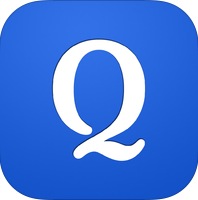Bridging educational gaps with mobile apps

With the release of the Apple App Store in 2008, apps from a wide variety of categories have become popular for consumers of all ages.
The education category, in the case of children and teens, is designed to help students with their academics.
Many students use Evernote, Google Chrome, and Google Drive—three apps that are recommended by teachers as well.
“On the first day of school, I had all my students download these three apps (if they didn’t already have them), and I require they be used in my class every day,” Upper School English Teacher Ohad Paran said.
He emphasizes the use of these three apps in particular because all the data gets backed up onto Cloud. Google Drive is one of the apps that he values the most because of its easy accessibility and the fact that his work is always backed up.
“I grade [the essay], and then send it back to them electronically,” Paran said. “No paper to print, no paper to lose. No need for a binder. I don’t have a filing cabinet in my classroom because all my files are in the cloud.”
Paran encourages students to continuously back up their files, which these three apps do, in order to avoid the stress of redoing work in case a laptop is stolen or crashes.
In addition to Evernote, Google Chrome, and Google Drive, apps such as Quizlet and Memrise help students study before tests and quizzes. Instead of using old-fashioned paper notecards, Quizlet allows students to create online notecards, which can be used as tools to help studying.
Quizlet was first released in 2007 by Andrew Sutherland, and in 2012, it made its first appearance on the App Store. Quizlet helps with the memorization of certain sets of information, for example learning vocabulary for languages. Users can create sets of flashcards, where they can input terms they need to memorize, which can then be studied in various modes: Learn, Speller, Space Race, Scatter, and Test. These modes help users test themselves, making memorization easier.
Along with Quizlet, Memrise is another community-driven tool students use to help learn new courses and languages. Ed Cooke and Greg Detre launched Memrise in 2010.
Lucas Wang (9) has been using the app for the past year and believes it to be extremely beneficial.
“The best part is the community because everyone from around the world posts different sets on different things. I started to relearn Spanish and even explore some French with it,” he said..
Many other apps such as Dictionary.com, Thesaurus.com, Khan Academy, and Notability are also used by students on a daily basis. Currently on the App Store, Lumosity Mobile, Duolingo, and Quizlet are in the top ten for most popular free educational apps.
This article was originally published in the pages of the Winged Post on April 4, 2014.
Raveena Kapatkar (12) is the Co-Editor-in-Chief of Harker Aquila. She is a senior and this is her fourth year on staff. As a freshman, she was a reporter...


















![“[Building nerf blasters] became this outlet of creativity for me that hasn't been matched by anything else. The process [of] making a build complete to your desire is such a painstakingly difficult process, but I've had to learn from [the skills needed from] soldering to proper painting. There's so many different options for everything, if you think about it, it exists. The best part is [that] if it doesn't exist, you can build it yourself," Ishaan Parate said.](https://harkeraquila.com/wp-content/uploads/2022/08/DSC_8149-900x604.jpg)




![“When I came into high school, I was ready to be a follower. But DECA was a game changer for me. It helped me overcome my fear of public speaking, and it's played such a major role in who I've become today. To be able to successfully lead a chapter of 150 students, an officer team and be one of the upperclassmen I once really admired is something I'm [really] proud of,” Anvitha Tummala ('21) said.](https://harkeraquila.com/wp-content/uploads/2021/07/Screen-Shot-2021-07-25-at-9.50.05-AM-900x594.png)







![“I think getting up in the morning and having a sense of purpose [is exciting]. I think without a certain amount of drive, life is kind of obsolete and mundane, and I think having that every single day is what makes each day unique and kind of makes life exciting,” Neymika Jain (12) said.](https://harkeraquila.com/wp-content/uploads/2017/06/Screen-Shot-2017-06-03-at-4.54.16-PM.png)








![“My slogan is ‘slow feet, don’t eat, and I’m hungry.’ You need to run fast to get where you are–you aren't going to get those championships if you aren't fast,” Angel Cervantes (12) said. “I want to do well in school on my tests and in track and win championships for my team. I live by that, [and] I can do that anywhere: in the classroom or on the field.”](https://harkeraquila.com/wp-content/uploads/2018/06/DSC5146-900x601.jpg)
![“[Volleyball has] taught me how to fall correctly, and another thing it taught is that you don’t have to be the best at something to be good at it. If you just hit the ball in a smart way, then it still scores points and you’re good at it. You could be a background player and still make a much bigger impact on the team than you would think,” Anya Gert (’20) said.](https://harkeraquila.com/wp-content/uploads/2020/06/AnnaGert_JinTuan_HoHPhotoEdited-600x900.jpeg)

![“I'm not nearly there yet, but [my confidence has] definitely been getting better since I was pretty shy and timid coming into Harker my freshman year. I know that there's a lot of people that are really confident in what they do, and I really admire them. Everyone's so driven and that has really pushed me to kind of try to find my own place in high school and be more confident,” Alyssa Huang (’20) said.](https://harkeraquila.com/wp-content/uploads/2020/06/AlyssaHuang_EmilyChen_HoHPhoto-900x749.jpeg)


